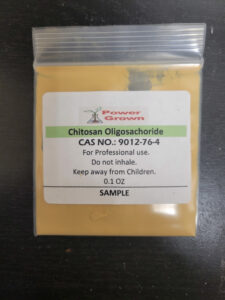Chitosan Oligosaccharide comes in its highest purity available at 85%. Food grade for consumable plants.
- Comes in a resealable bag.
- Usage instructions and information are added in your order.
Chitosan Oligosaccharides, is a by-product of the alkaline deacetylation of chitin. Chitin is a polysaccharide, the second most abundant naturally occurring polymer. It is found on the shells of arthropods such as crustaceans and insects (Hadrami, Hadrami, Adam, & Daayf, 2010). Chitin contains nitrogen that is used in pharmaceuticals. The production of chitosan from chitin involves four major steps that aims at removing protein and calcium components from the raw shells. The chitin is treated with about 40% of sodium hydroxide during the de-protenization and de-mineralization process to make chitosan. Chitosan is soluble in acidic solutions and precipitates in high pH environments. The physical and chemical properties of chitosan are dependent on its molecular weight and the degree of deacetylation (Sarmento & Neves, 2012).
Chitosan has been linked to a number of biological and physiological activities in the human body. Studies carried out have shown its unique biological activities that include anti-oxidant, anti-inflammation, biological recognition, and enhancing immunity among others, (Guo et al., 2018). This has resulted use of chitosan was to treat a number of illnesses. These illnesses include high cholesterol, Crohns’ disease, kidney failure, dental cavities, and hyperphosphatemia (Liu, Xin, Liu, Zhang, & Li, 2017).
Other than the links in the human biological and physiological activities; chitosan has shown great potential in agriculture regarding controlling of plants’ diseases. With the high demand of blemish free farm products that require high input, chitosan has allowed this achievement while ensuring the produce yields profits (Hadrami, Hadrami, Adam,, &Daayf, 2010).
Chitosan has made this possible by reducing the disease levels and the spread of pathogens in plants. Additionally this has helped preserve the yield and quality of the produce. The chitosan molecules have exhibited toxicity and inhibit fungal growth and development. (Xing, Zhu, Peng, &Qin, 2014).
Fragments from chitosan elicit defense responses in the host plants in regards to microbial infections. The responses provided by chitosan include lignification, protein phosphorylation, membrane depolarization, and generation of reactive oxygen species among others. The toxicity demonstrates anti-viral, anti-bacterial, and anti-fungal properties that allow the protection of plants against several diseases. This has allowed for agricultural exploration since the diseases can now be controlled and the pests kept away. Chitosan is effective to both monocotyledons and dicotyledons by enhancing the plants’ defense responses (Xing, Zhu, Peng, & Qin, 2014).
The only side effects observed were mild transiently nausea and constipation. Individuals are always advised not to take chitosan with warfarin. This is because chitosan is known to be a blood thinner. Taking chitosan with warfarin exposes an individual to several risks such as bruising easily. Acyclovir (Zovirax) interacts with chitosan, taking chitosan with acyclovir might reduce the amount of acyclovir the body absorbs. This might reduce the effects of acyclovir.
Parts Per Million for Agricultural Use The antimicrobial activities exhibited by chitosan depends on several factors. These factors include the plant in question, the degree of polymerization, type of chitosan used, chemical composition of the substrate, as well as the environmental factors (Hadrami,Hadrami, Adam, & Daayf, 2010).
In viruses and bacteria, the minimal growth-inhibiting concentrations vary between 10-1000 parts per million. On fungi, the minimal growth-inhibiting concentrations vary between 10-5000 partsper million.
References Guo, X.,Sun, T., Zhong, R., Ma, L., You, C., Tian, M.Wang, C. (2018). Effects of Chitosan Oligosaccharides on Human BloodComponents. Frontiers in Pharmacology, 9.doi:10.3389/fphar.2018.01412 Hadrami, A. E.,Hadrami, I. E., Adam, L. R., & Daayf, F. (2010).Chitosan in Plant Protection. Marine Drugs, 8(4),968-987. doi: 10.3390/md8040968 Liu, L.,Xin, Y., Liu, J., Zhang, E., & Li, W. (2017). ). InhibitoryEffect of Chitosan Oligosaccharide on Human Hepatoma Cells in Vitro. AfricanJournal of Traditional, Complementary and Alternative Medicines, 14(4),272-277. doi:10.21010/ajtcam.v14i4.30 Sarmento, B., &Neves, J. D. (2012). Chitosan-Based Systems forBiopharmaceuticals: Delivery, Targeting and Polymer Therapeutics. Hoboken,NJ: John Wiley & Sons. Xing, K.,Zhu, X., Peng, X., & Qin, S. (2014). Chitosan antimicrobialand eliciting properties for pest control in agriculture: A review. Agronomyfor Sustainable Development, 35(2), 569-588.doi:10.1007/s13593-014-0252-3
Additional information
| Weight | 4 oz |
|---|
This site uses Akismet to reduce spam. Learn how your comment data is processed.







Reviews
There are no reviews yet.